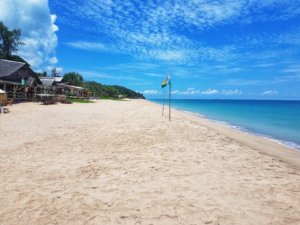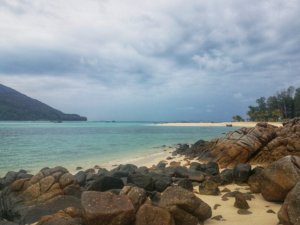When prospective travelers hear “monsoon” or “rainy” season, many are immediately turned off by the idea of traveling to such a place during a soaking wet time of year. However, travel to Southeast Asia in the rainy season is a chance explore places often too crowded or expensive.

This time of year does bring its challenges and frustrations, Days may not be as long and sunny as days enjoyed other times of year, but the sun still comes out!
Sometimes it does rain all day, but the rainy season is an opportunity to travel in Southeast Asia and experience places in ways you cannot in the busier dry season.
The most attractive aspect of travel to Southeast Asia in the rainy season is the affordability.
What should you know before you travel to Southeast Asia in the rainy season? Here are some preparation tips and considerations for what to do:
Contents
Packing for the Rainy Season
The most important thing to consider when traveling anywhere, especially for travel to Southeast Asia in the rainy season, is what to pack. This time of year in Southeast Asia is not only hot. It’s now wet. A normally humid environment becomes a sauna.
First and foremost, invest in a quality rain jacket. Don’t buy the tempting knockoff in market stalls. It may seem like a deal in the moment, but the water-repellent nature may quickly wear off or be absent entirely. When purchasing this rain jacket, find one that has ventilation. Usually these have zippers under the arms or on the back. With this, you can stay dry and keep cooler. It is still hot, and ventilation is a good idea, lest you want to develop a musty stench.
A lightweight poncho is also an item to consider packing for times when the heavy rains are too much even for a quality rain jacket.
A small umbrella is another good thing to pack. Cheap ones are occasionally for sale on city streets. The umbrella can double as protection from the sun for on days of oppressive heat.

If you’re going to wear sandals, which I do not recommend away from beaches, wear sandals with straps. Big city streets in Southeast Asia are gross. Sure, that puddle looks like water, but there is no telling what sort of filth is the city’s runoff. Uncovered feet will be dirty in no time.
During the rainy season, travel to Southeast Asia can be a messy affair. City streets will leave sandal-wearers with a nice layer of grime. Shoes are bound to get dirty, but in the interest of foot protection and cleanliness, a solid pair of shoes is a must.
Check out this series on packing for more insight.
Rainy Season Travel Deals
Southeast Asia is a cheap place to travel. Southeast Asia during the rainy season is a very cheap place to travel.
The bulk of travelers visit Southeast Asia from September to February, give or take a month. In general, this is the dryer, cooler time of year for the region. There are variations within the region, of course. For example, Northern and Southern Thailand have differing seasons, and, in Vietnam, a day of cold and damp in Hanoi can be blistering hot in Ho Chi Minh City.

Regular heavy rains generally begin in summer, in May or June. Weather is a crapshoot, though, and there’s no surefire guarantee of anything. It is important to note the subregional variations and research accordingly before your departure.
Accommodation is the biggest money-saver in Southeast Asia rainy season travel. Hotels, guesthouses and hostels have more vacancies with fewer travelers in the region. As the law of supply and demand dictates, prices go down.
Some of the best deals are seaside. Beachfront lodging in many places, specifically the Thai islands, can be as much as 75% cheaper.
In cities that draw visitors for more than tourism, the change is not as significant. But hotels in overpriced Yangon (accommodation), and backpacker options in crazy Bangkok will be a few bucks cheaper. Guesthouses in tourist towns like Luang Prabang drop prices as well.
Transportation can also be cheaper in the rainy season. Specifically, short regional flights are cheaper in the wetter months. Bus rides are cheaper, too, but there is the chance of fewer buses running regularly when the sky is falling. Water transportation is cheaper in that it is hardly an option in the dry season.
Fewer Tourists
The best part about rainy season travel in Southeast Asia – yes, better than saving money – is fewer tourists. Throughout the rest of the year, tourist numbers swell in many popular places.
Picture the tropical paradise you’ve imagined, that you’ve see online, and (deep down) you know is full of other people just beyond the frame. Now imagine seeing beyond the frame and the beach is still empty. That’s what Southeast Asia travel can be in the rainy season.

Popular destinations such as the Temples of Angkor remain busy throughout the year. Other destinations, such as (most of) the Thai Islands and Si Phan Don (4000 Islands, Laos) are highly seasonal.
Overall, there are fewer foreign visitors in Southeast Asia during the rainy season, making for a great reason to travel during those months.
Great Time to Work
The age of the digital nomad is here. “Digital nomad” is a catchy term for people who work remotely and use this as an excuse to travel and work from around the world. The rainy season is the perfect time to travel to Southeast Asia for those who work remotely.
If a computer with an internet connection is all you need, it’s fairly easy to work from anywhere. Digital nomads are often seen in coffee shops and hotels doing whatever it is they do for a few hours a day. The flexibility in job location allows them to work from fantastic places around the world. In the rainy season of Southeast Asia, digital nomads enjoy the sunshine and travel part of their life in between rains.
The rainy season is also a great time for independent travel writers and bloggers (yours truly) to travel cheaper in Southeast Asia and maximize research with smaller crowds around.
Most of us do not have the luxury to work remotely behind a computer. If the opportunity does present itself, consider the cheap living and great eating in Southeast Asia as a working getaway.
Museums & Restaurants
Rain dampens travel experiences and expectations, especially if sunny days are what you have in mind. If you know you’re going to a place with a lot of rain – and research accordingly, beforehand – rainy days can be an opportunity.
Southeast Asia is known for pristine beaches, ancient jungle ruins, crazy street food and beautiful landscapes. But there is a lot more to Southeast Asia, and plans change when Mother Nature is uncooperative.
When the rainy season in Southeast Asia puts a dagger in your travel plans, it’s time to utilize that extra research. This is the chance to visit local museums, events and restaurants.

The big cities of Southeast Asia offer many alternate activities for rainy days, such as:
Bangkok is a massive city with dozens of museums and galleries to fill your time. Kuala Lumpur has more malls than can possibly be healthy. But malls are more than shopping in Malaysia. They are a part of local life and the Malaysian experience. Hanoi is home to a famous women’s museum. Ho Chi Minh City has national museums and the popular War Remnants Museum.
Rainy days are also great excuses to visit restaurants. Where street food is king, food-focused travelers often overlook brick-and-mortar dining options. Consider a few options and take the time to sit down and explore some new menus. And maybe throw back a few local cocktails to get the full local experience.
Other easy activities out of the rain:
Markets are typically open air, but covered. Southeast Asia may have the best markets in the world, and there is no better way to explore a city than through its markets. Catching a movie is one of my favorite rainy day activities. It sounds typical, but catching a movie in Southeast Asia is a fun, peculiar experience.
With a little preparation, you can make the best of travel in Southeast Asia during the rainy season. There is definitely plenty to do!
Disadvantages of Rainy Season Travel in Southeast Asia
Having backup plans in line is the best way to prepare for travel to Southeast Asia in the rainy season. But even with a whole host of alternate activities in mind for rainy days, traveling in this season does not come without disadvantages.
For beachgoers, there is no denying that there are fewer sunny days. You may have luck and see a streak of a few days without rain, or the rain may hold off each day until late afternoon, but don’t count on it.

Transportation, while often cheaper in the rainy season, can make travel in Southeast Asia difficult. For example, rough seas cause several ferry routes to cease operations for several months a year. In more rugged, mountainous areas, seasonal downpours can damage the integrity of roads and cause landslides. Thus, roads close making travel difficult or impossible.
At times, the downpours in Southeast Asia are so severe that you can’t go anywhere. Streets are empty and locals disappear. These storms are usually temporary and normal life quickly resumes. As a traveler, there isn’t much you can do during these times other than exercise patience. If the forecast is this grim, booking accommodation in a central location near the highlights of the destination is a good idea.
Weather is a major factor when traveling. Forecasts are never certain and skies can change in a moment’s notice. Travel in Southeast Asia during the rainy season is a fun ordeal unlike any other.
The wet season can make travel frustrating, but, with a little preparation, it is also a great time to go. Fewer tourists, discounts and a fresh look at Southeast Asia make for an exciting adventure.
Leave a Reply
You must be logged in to post a comment.